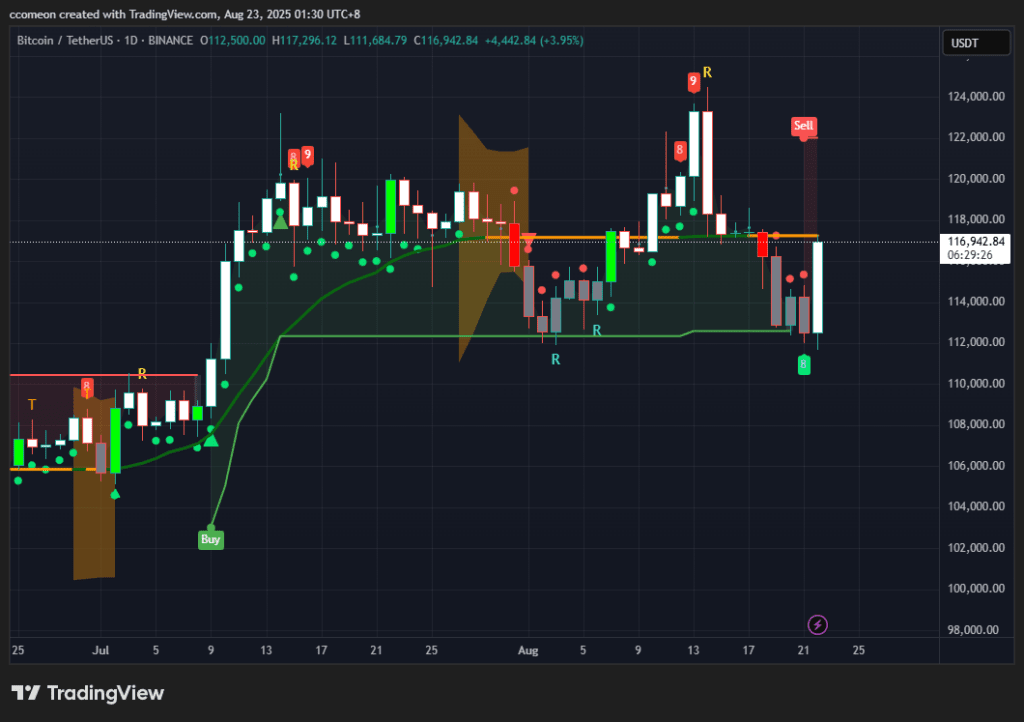Market review: BTC rose from $111,000 to $117,000.
The market began to pull back in mid-August, both in U.S. stocks and the cryptocurrency market, primarily because most U.S. economic data released were better than expected, indicating that the U.S. economy remains robust. This situation is unfavorable for rate cuts, and market expectations are that Powell will maintain a non-cutting tone in his speech on Friday, leading to strong risk-averse sentiment, which caused the cryptocurrency market to decline, with spot ETFs also recording net outflows for five consecutive days.
However, after Powell's speech on Friday, comments suggesting the possibility of adjusting monetary policy were released, which the market interpreted as support for a September rate cut to boost the labor market. As a result, the stock and cryptocurrency markets quickly regained upward momentum, with BTC soaring from a low of $111,000 to $117,000, ETH also breaking above $4,880 to reach a new high, with a daily increase of nearly 15%, and BNB also setting a new high, reigniting market sentiment.
Outlook for next week: Expectations of rate cuts are heating up, and the market is likely to rise.
Powell's remarks suddenly reversed market sentiment, significantly increasing the probability of a rate cut in September, so the expectation is that market performance will be relatively optimistic next week. If no significant negative news emerges next week, BTC and ETH may break new highs, and weekend market performance is also worth looking forward to. There are not many important economic data releases at the beginning of the week in the U.S. market, with GDP announced on Thursday and Friday likely to have a larger impact on the market.
Currently, Bitcoin's daily line has rebounded strongly after breaking the trendline at $112,000, so it can be expected that there will be opportunities to break through $117,000 and return to the long-term upward trend line. At present, Bitcoin is relatively weaker compared to other coins like ETH, or in other words, it is stabilizing in the range of $113,000 and $118,000. As long as Bitcoin does not experience a significant price drop, the trends of other mainstream coins will also be relatively optimistic.

Powell hinted at possible rate cuts, a summary of the Jackson Hole speech content.
Federal Reserve Chairman Powell delivered a speech titled 'Economic Outlook and Review of Framework' at the annual symposium held by the Federal Reserve Bank of Kansas City in Jackson Hole, Wyoming. The speech focused on the current state of the U.S. economy, recent challenges, and updates to the Fed's monetary policy framework. Here are the main points summarized:
Economic outlook
Despite recent policy changes, the U.S. economy is showing resilience but is facing headwinds from higher tariffs and stricter immigration policies, affecting both supply and demand.
In the first half of 2025, GDP growth slowed to 1.2%, compared to 2.5% in 2024, primarily due to reduced consumer spending and slower supply growth.
Inflation
The personal consumption expenditures (PCE) inflation rate for the 12 months ending July 2025 is 2.6%, with core PCE at 2.9%, higher than the previous year.
Higher tariffs have led to rising product prices, which could bring short-term inflation effects. However, long-term inflation expectations remain anchored to the Fed's 2% target.
Risks include a potential wage/price spiral or unanchoring of expectations, although this has not yet materialized.
Employment situation
The labor market is close to full employment, but signs of cooling are appearing, with both labor supply and demand slowing.
In the past three months, the average monthly job growth was only 35,000, a significant drop from 168,000 in 2024. Recent data revisions indicate an even steeper decline.
The unemployment rate has stabilized at 4.2% over the past year, but the downward risks to employment are increasing, which may lead to more corporate layoffs.
Monetary policy
The federal funds rate remains restrictive but is closer to neutral levels by 100 basis points compared to last year.
Inflation risks are tilted upward, while employment risks are tilted downward. The Federal Open Market Committee (FOMC) will carefully balance the dual mandate of price stability and full employment, adjusting policy based on incoming data without a preset path.
Powell stated that evolving conditions 'may require' rate cuts, and that caution should be exercised in the shift of risks.
The main highlight is the revision of the Fed's (long-term goals and monetary policy strategy statement), now emphasizing a flexible inflation target, removing explicit focus on the effective lower bound (ELB) for interest rates, and providing clearer guidance to manage the trade-off between employment and inflation targets. This update reflects changes in the economic environment over the past five years, aimed at enhancing transparency and adaptability.
Overall, his speech maintained a balanced tone, continuing to keep inflation and employment conditions in balance while emphasizing the need for vigilance in a changing environment. Market and media interpretations show Powell leaning dovish toward a neutral shift in economic policy, indicating that the Fed may start cutting rates in September, but he still tends to rely on data, aiming to revive the labor market without reigniting inflation.



